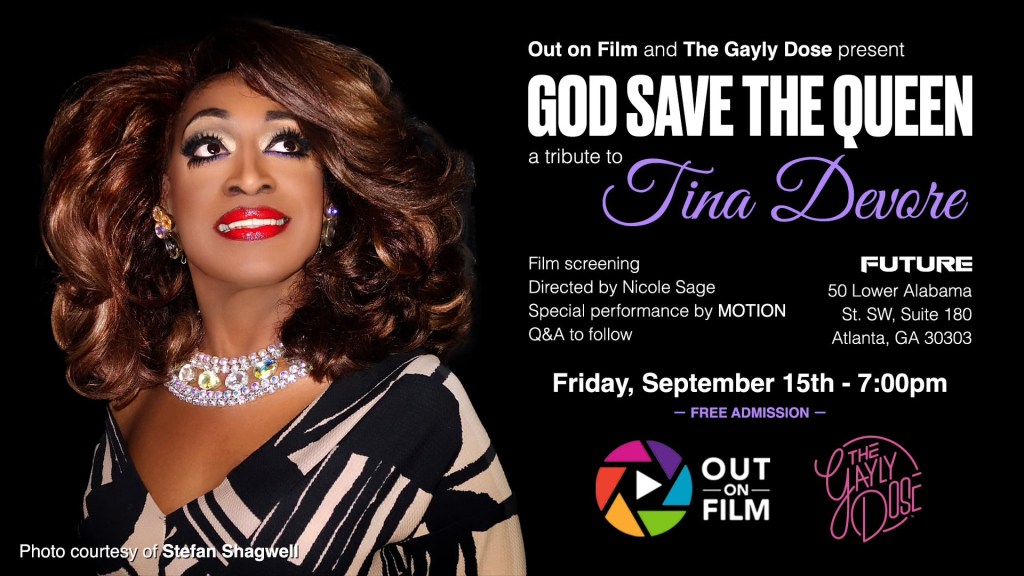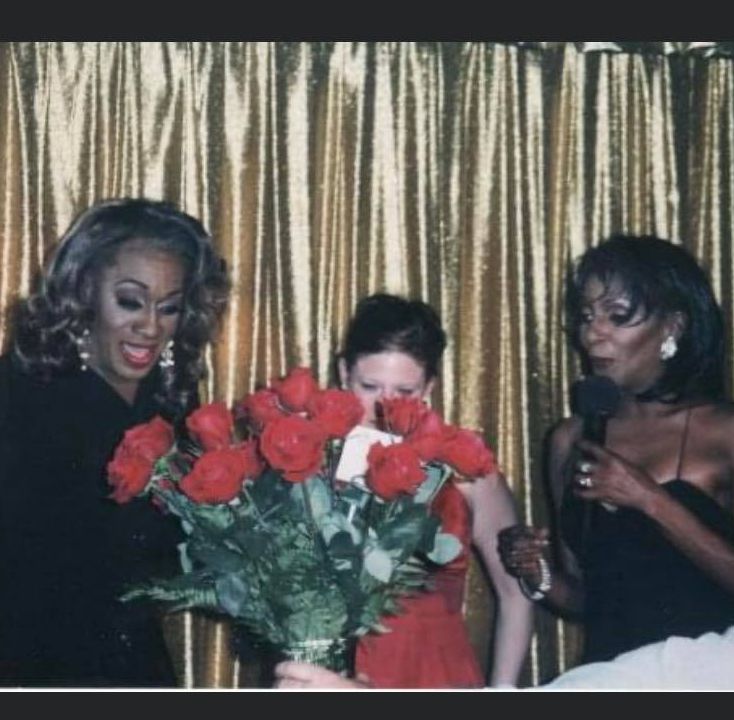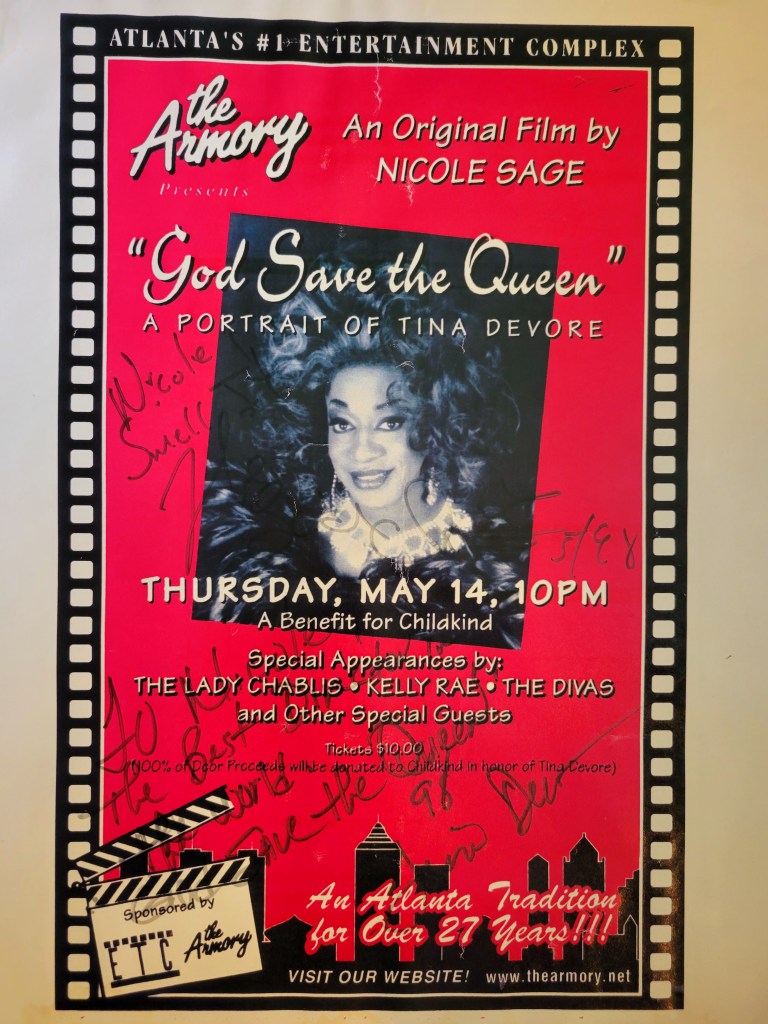
Out on Film and The Gayly Dose podcast are celebrating legendary Atlanta drag queen Tina Devore with a screening of the short documentary “God Save the Queen.”
Directed by Nicole Sage, “God Save the Queen” was shot 25 years ago in 1998. The anniversary screening will be held at Future Atlanta at 50 Lower Alabama Street on Sept. 15 at 7 p.m. The event is free to attend, and will also include a Q&A session moderated by Helmut Domagalski of The Gayly Dose and a performance by Atlanta drag queen Motion.
Sage, who is now a publicist, attended film school at Georgia State University. Originally from Connecticut, her grandfather made sure that she took acting lessons growing up, but Sage always felt that she wanted to be on the other side of things.
“I quickly saw [that] acting is not what I wanted to do,” Sage said. “I wanted to learn how to tell stories with all the things that I possess in terms of my talents, and tell the stories in a film medium.”
While she was in film school, Sage met Tina Devore for the first time and immediately knew that she wanted to make a film about her. She began thinking about the prospect of an anniversary screening a few years ago, and while she’s happy Out On Film is able to help make it happen now, she is saddened that Tina can’t be there. The performer passed away in 2021.
Rough Draft spoke with Sage about the making of the film and Tina’s legacy ahead of the screening. This interview has been edited for length and clarity.
When did you first become aware of Tina and how did that lead into making her the subject of this film?
Nicole Sage: When I was little, I used to spend my summers at summer camp in Cape Cod. On parent visitation day, my mom would hide me in her backseat and sneak me off camp so that we could go to P Town [Provincetown] in Cape Cod and eat lobsters. Have you ever been to P Town?
I’ve never been, but I’ve heard of it.
Sage: It’s super gay! When we were sitting there, I was probably like seven or eight years old … and I saw these two men wearing leathers, roses in the mouth, holding hands, skipping down the street. And I was like, “Mommy! Why are those men holding hands skipping down the street?” She leaned over, and she was like, “Those are special friends.”
In college, I had friends that worked at gay bars. They’d be like come and see me, come see the shows. I loved them. I loved the drag shows. This was at the time [of] Burkhart’s, The Armory, Backstreet – because this was the mid-90s. I got to see The Gospel Girls … I saw how moving it was, because it was like their church. It wasn’t fundamentalism, you know? People were there, and that’s their church. That was their way to celebrate their spirituality, which I really loved.
I was introduced to Tina by one of my friends from high school – he was one of my favorite people, he was like my Duckie, if I was “Pretty in Pink.” Tyler was a bartender at Burkhart’s, and he was like – you have to meet Tina. So I meet Tina, and then it hit me. I’m like, oh my god – I want to make a movie about you. I want to do a documentary all about you – as much as I can for this amount of money [laughs]. Can we make a movie about you, your whole life, in 15 minutes? Great [Laughs]. I just loved the way that she conducted herself. She was such a classy presence. Regal, you know? Really composed and elegant.
It also happened to be when “Midnight in the Garden of Good and Evil” came out, which was filmed in Savannah. Have you ever seen that movie?

I have not, but I’ve heard of it.
Sage: You know it – John Cusack, Kevin Spacey. In the book [the book the movie is based on, written by John Berendt] … he wrote about the Lady Chablis, who was a drag queen out of Savannah. She was getting tons of publicity because she was playing herself. They didn’t cast an actor to play Chablis, they casted her. Her performance was so phenomenal, and I found out from Tina that Chablis was her drag mother. I was like, can I interview Chablis for my movie? And she said yes.
So, originally “God Save the Queen” was supposed to be about Tina with Chablis, Motion, Paula St. Claire, and Crystal Evans. But when we had made all the arrangements, we were all set up – lighting, camera, everything – [Chablis] got arrested the night before and missed her call time.
It was a huge disappointment, because that was going to be the big kicker. That was going to be like the money shot, was having Chablis doing testimony about Tina in the movie. But regardless, the show must go on. We did the best that we could with what we had. It couldn’t be just all about her, and we were very limited with what we had to work with, because I had $10,000, you know? What I wanted, or what I feel that we got, was like a resume, if you will – like a portfolio, so that when I graduated from film school and moved to Los Angeles, I would screen it for people hoping [they would say], oh my gosh – I love this story about Tina, and I’ll give you more money to finish it. That’s what I was really hoping for. Or, here’s money to fix the editing. The editing was so expensive.
You mention the editing and how long it took. I know it’s been a long time, so you might not necessarily remember, but was it difficult to cut some of the footage, or was there anything you had to cut that you didn’t necessarily want to?
Sage: Well, the thing that I wish that we had gotten was the interview with Lady Chablis that was supposed to be intermittent throughout it all. I had 30 minutes-worth of film that I had bought for her piece, because we were going to highlight how she was Tina’s drag mother, and do a number from Chablis and then do the number from Tina to see how it’s passed down.
We got what we could, and then we had to see if it developed correctly, which it did. But the editing was the most expensive – way more than anything else … Even though I was a student in school, you had to pay for the [editing] suite by the hour. It took time to transfer the film and upload it into the system, and you had to pay. So if it took six hours to render 20 minutes, I had to pay for six hours of editing, just to upload the thing. That was like, two grand, you know, of my $10,000.

I had to borrow $3,000 more to fix the audio, and when we pieced it together, we didn’t see that the levels were amiss in one component of the one-on-one interview with Paula St. Claire. I came [into class], I was so defeated – I was so sad. My film teacher … is like, what’s the matter Nicole? I’m like [In a fake crying voice] – my movie is ruined! He was like, why? Because I didn’t know the audio was amiss! I didn’t see it on the levels!
He’s like, well let me see it. I showed it to the class, and everybody was like, wow! Okay! Nobody did a documentary, you know? He was like – okay, I see what you’re saying Nicole. But believe me, it’s not a big deal because nobody cares what she’s saying. Everybody is too busy looking at her tits. That’s what he said! In front of everybody!
I wanted to talk about the performance of Tina’s that is interspersed throughout the film, of “Here’s To Life.” Why did you pick that performance in particular?
Sage: I saw her perform it before we started. And when Tina was like, what number do you want me to do? I was like, you have to do “Here’s to Life.” And do you have anything that’s angelic, white? And she was like, oh yes – you know, her sequined gown, and all the rhinestones.
At the beginning, you see Webster says what an angel is. That’s who Tina was in the community. She was regarded as elegant, angelic, kind – the opposite of the Charlie Brown persona. The opposite of, every drag queen is a bitchy queen. She was not bitchy at all, and she had this very positive outlook on life … I loved the message. As a society, even back in 1997, 1998, we were not remotely evolved socially. The reason why this film is so poignant is because we’re not even evolved today, in 2023, 2024. The needle hasn’t moved. Even with all of the popular culture – so obsessed with “RuPaul’s Drag Race” – we’re not where we should be, in my opinion. There’s a lot wrong. There’s so much wrong, and it’s like, why haven’t we learned from our past mistakes? So I wanted her to perform something that was inspirational.
Well it’s a great song, and a beautiful performance.
Sage: Yeah, I think so too. I just caught a glimpse of it yesterday, because we scouted the location where the film is being held. I started crying, because I haven’t watched it like that in so long … She died during the pandemic, and she can’t even be here for it. We talked about it. I said, let’s do a 20-year anniversary. She wanted to … We stayed in touch. My goal was to make an all-out, high-budget, feature film documentary on her. I just thought that someone would want to see that made.
Has anything come of that? Or is there any possibility for that in the future?
Sage: I would love it if somebody would like to hire me as a director and a writer and a producer to do one. There’s nothing really that I can do to extend the film “God Save the Queen,” because number one, one of the reasons why it wasn’t in film festivals for shorts is I couldn’t afford to buy the copyright for the music. So, “Here’s to Life,” all the Diana Ross – it was not more successful because I didn’t have the backing. Which is a bummer. But it’s also very indicative, you know. Can’t do much if you don’t have money.
You mentioned you had been talking previously about doing a screening for it, but how did this Out on Film event come about?
Sage: I became friends with Jim Farmer, who’s the executive director of Out on Film … I had lunch with him recently, and he was like – let’s show “God Save the Queen.” I’m like, where? What do you mean? [Laughs] I think it came about when Tennessee passed the law that performing drag is a crime [the state law placed strict limits on drag performers, and has since been ruled unconstitutional by a federal judge]. That incensed me. Talk about unevolved, okay? To me, performing drag is an art, and these are artists. This is their craft, and this is their talent. No one should be condemned for wanting to perform art. Period.
I said, you know what? We should. It’s got to be along the lines of, if drag is illegal where you live, you come over here and do drag next to me. That’s a line from Ouiser in “Steel Magnolias,” which I played in college. The line was, if you don’t have something nice to say, come over here and say it next to me. We wanted to advocate that at least Atlanta is evolved enough to never outlaw performing art. We thought that was important.
